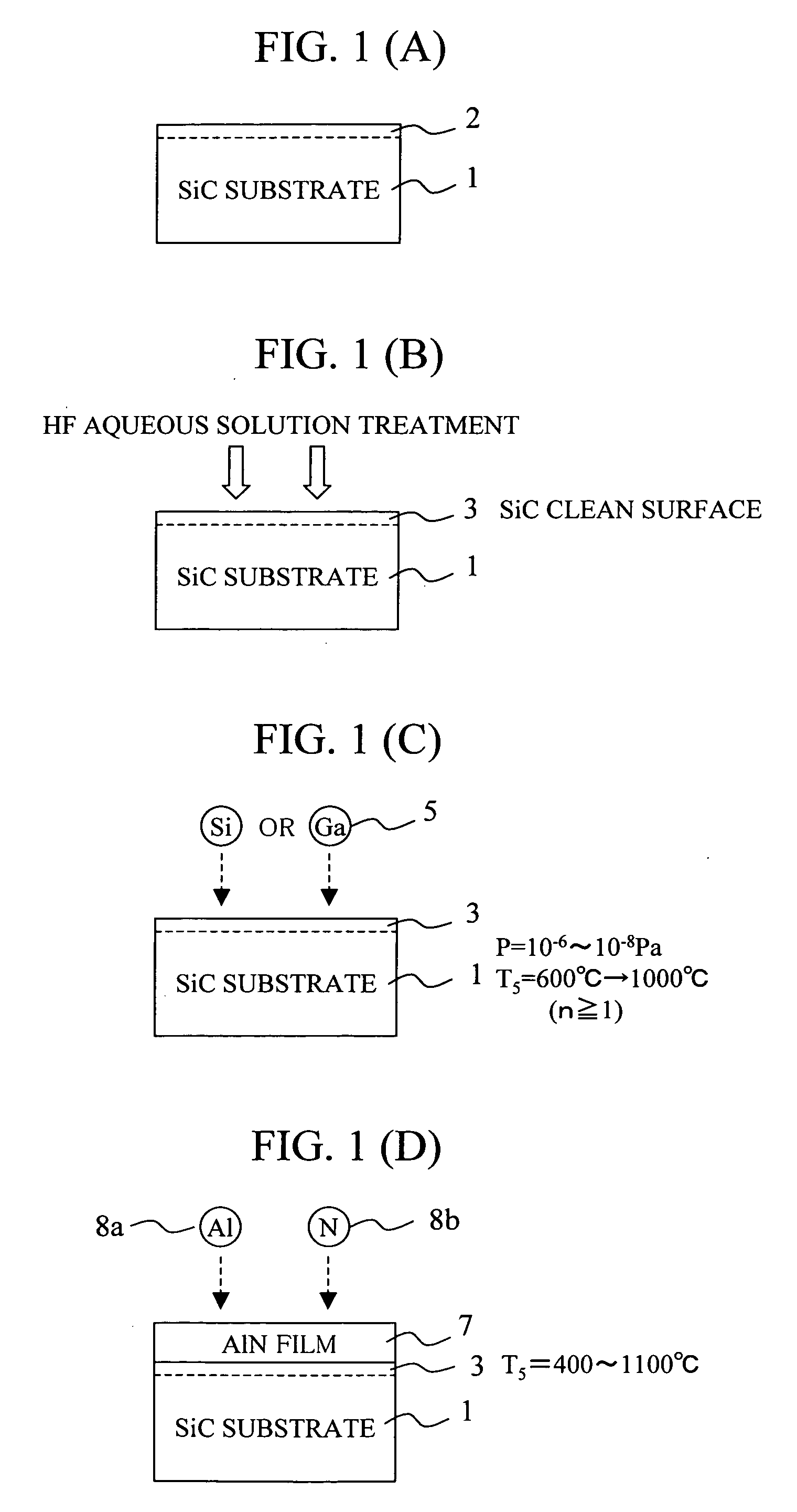Method of growing semiconductor crystal
- Summary
- Abstract
- Description
- Claims
- Application Information
AI Technical Summary
Benefits of technology
Problems solved by technology
Method used
Image
Examples
first embodiment
[0046] Thus, in accordance with the invention, after a SiC surface and a surface with common multiples of the total number of the molecules in the SiC surface and the AlN layer that is deposited thereon are prepared, the AlN layer is grown, whereby AlN can be formed on the SiC surface by layer-by-layer growth or step-flow growth (two-dimensional growth). As a result, defects are less likely to be introduced as compared with the conventional case of three-dimensional island growth, such that high-quality crystal growth can be achieved. During the AlN crystal growth, N may be intermittently fed while an Al beam is shone.
[0047] There are many steps on the SiC surface prior to the AlN growth. The heights of all of the steps preferably correspond to the least common multiples of the total number of the molecules of SiC and AlN. However, it is known that significant effect for achieving higher quality of the AlN crystal can be obtained even if some steps do not have such height as long as...
second embodiment
[0051] Hereafter, a crystal growth method according to the invention is described with reference to the drawings. FIG. 5 shows the steps of the crystal growing method according to the present embodiment. FIG. 6 shows a sequence chart regarding the timing of feeding of growth elements (which is controlled by turning on and off of a shutter, for example, in the case of MBE) before and after the crystal growth of a Group III nitride.
[0052] In the following, the crystal growth step in the present embodiment is described in detail with reference to FIGS. 5 and 6. As shown in FIG. 5(A), initially a washed 4H—SiC(0001)Si substrate 11 is prepared. Then, a clean surface 15 is formed on the surface of the substrate 11, as in the case of the above-described first embodiment. Thereafter, as shown in FIG. 5(B) and FIG. 6, the Al irradiation is carried out first at time t11. At time t12 (t12−t11=10 s, for example), when the surface of the SiC substrate 11 is substantially entirely covered with Al...
third embodiment
[0053] Hereafter, a crystal growing method according to the invention is described with reference to the drawings. FIG. 7 shows the steps of the crystal growing method according to the present embodiment, and FIG. 8 shows a sequence chart regarding the timing of feeding of growth elements (which is controlled by turning on and off of a shutter, for example, in the case of MBE) before and after the crystal growth of a Group III nitride.
[0054] In the following, the crystal growth steps in accordance with the present embodiment will be described with reference to FIGS. 7 and 8. As shown in FIG. 7(A), initially a washed 4H—SiC(0001)Si substrate 21 is prepared. Then a clean surface 25 is formed on the surface of the substrate 21 in the same manner as in the first and second embodiments. Thereafter, as shown in FIG. 7(B) and FIG. 8, at a certain time (time t20), the Ga irradiation is first carried out. Near the growth temperature of AlN, the vapor pressure of Ga is higher than the vapor p...
PUM
 Login to View More
Login to View More Abstract
Description
Claims
Application Information
 Login to View More
Login to View More - R&D
- Intellectual Property
- Life Sciences
- Materials
- Tech Scout
- Unparalleled Data Quality
- Higher Quality Content
- 60% Fewer Hallucinations
Browse by: Latest US Patents, China's latest patents, Technical Efficacy Thesaurus, Application Domain, Technology Topic, Popular Technical Reports.
© 2025 PatSnap. All rights reserved.Legal|Privacy policy|Modern Slavery Act Transparency Statement|Sitemap|About US| Contact US: help@patsnap.com



